In recent years, the application areas of hose packaging have gradually expanded. Industrial products have chosen hoses, such as lubricating oil, silicone, caulking glue, etc.; food has chosen hoses, such as mustard, hot pepper sauce, etc.; pharmaceutical ointments have chosen hoses, and the hose packaging of toothpaste is also constantly upgrading. More and more products in different fields are packaged in "hoses", and in the cosmetics industry, hoses are easy to squeeze and use, light and easy to carry, customizable specifications, custom printing, etc., so cosmetics, daily necessities, and cleaning products all like to use cosmetic hose packaging.
Product Definition
The hose is made of PE plastic, aluminum foil, plastic film and other materials, and is made into sheets by co-extrusion and compounding processes, and then processed into a tube-shaped packaging container by a special tube-making machine. The hose has the characteristics of light weight, easy to carry, strong and durable, recyclable, easy to squeeze, good processing performance and printing adaptability, and is favored by many cosmetics manufacturers.
Manufacturing process
1. Molding process
A. Aluminum-plastic composite hose
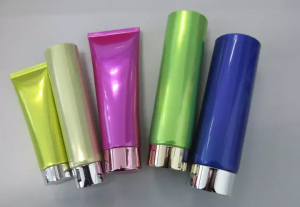
Aluminum-plastic composite hose is a packaging container made of aluminum foil and plastic film through co-extrusion composite process, and then processed into a tube by a special tube making machine. Its typical structure is PE/PE+EAA/AL/PE+EAA/PE. Aluminum-plastic composite hose is mainly used to package cosmetics with high requirements for hygiene and barrier properties. Its barrier layer is generally aluminum foil, and its barrier property depends on the pinhole degree of the aluminum foil. With the continuous improvement of technology, the thickness of the aluminum foil barrier layer in the aluminum-plastic composite hose has been reduced from the traditional 40μm to 12μm, or even 9μm, which greatly saves resources.
B. All-plastic composite hose
All plastic components are divided into two types: all-plastic non-barrier composite hose and all-plastic barrier composite hose. All-plastic non-barrier composite hose is generally used for the packaging of low-end fast-consumption cosmetics; all-plastic barrier composite hose is usually used for the packaging of medium and low-end cosmetics due to the side seams in the tube making. The barrier layer can be a multi-layer composite material containing EVOH, PVDC, oxide-coated PET, etc. The typical structure of all-plastic barrier composite hose is PE/PE/EVOH/PE/PE.
C. Plastic co-extrusion hose
Use co-extrusion technology to co-extrude raw materials of different properties and types together and form them in one go. Plastic co-extrusion hoses are divided into single-layer extrusion hoses and multi-layer co-extrusion hoses. The former is mainly used for the packaging of fast-consumption cosmetics (such as hand cream, etc.) with high requirements for appearance and low requirements for actual performance, while the latter is mainly used for the packaging of high-end cosmetics.
2. Surface treatment
The hose can be made into colored hose, transparent hose, colored or transparent frosted hose, pearlescent hose (pearlescent, scattered silver pearlescent, scattered gold pearlescent), and can be divided into UV, matte or glossy. Matte looks elegant but is easy to get dirty. The difference between colored hose and large-area printing on the tube body can be judged from the cut at the tail. The white cut is a large-area printing hose, and the ink used is required to be high, otherwise it is easy to fall off and will crack and reveal white marks after being folded.
3. Graphic printing
The commonly used methods on the surface of the hose are silk screen printing (using special colors, small and few color blocks, the same as the printing method of plastic bottles, color registration is required, and it is commonly used for professional line products), offset printing (similar to paper printing,large and colorful color blocks, commonly used for daily chemical line products.), and hot stamping and hot silver. Hose processing usually uses lithographic offset printing (OFFSET), and most of the inks used are UV-dried, which usually requires strong adhesion and color change resistance. The printing color should be within the specified depth range, the overprint position should be accurate, the deviation should be within 0.2mm, and the font should be complete and clear.
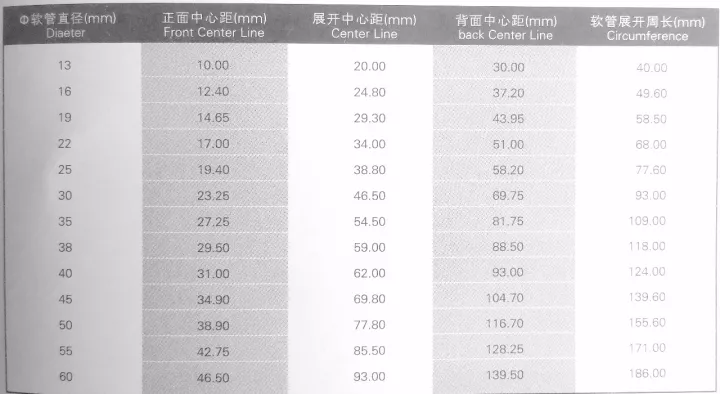
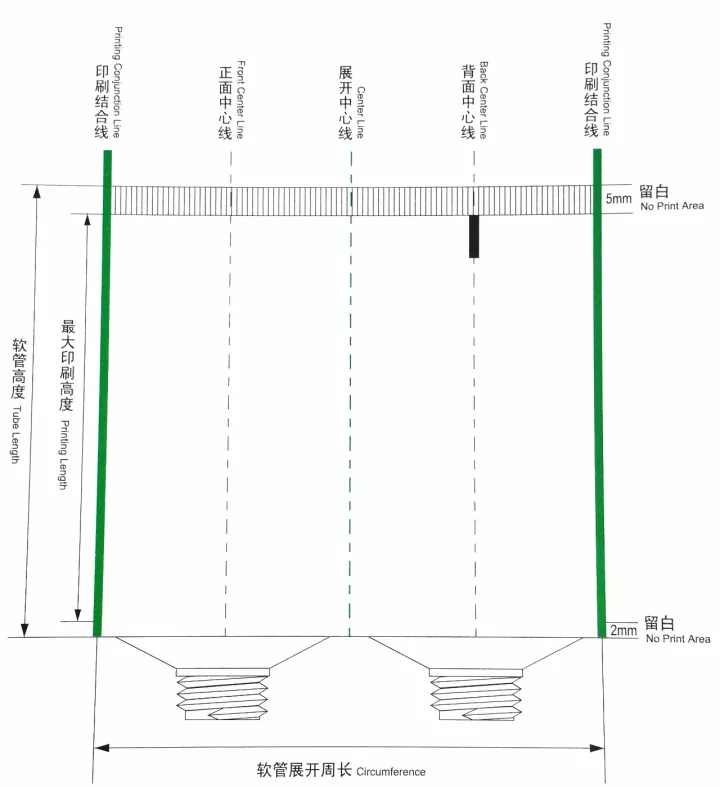
The main part of the plastic hose includes the tube shoulder, tube (tube body) and tube tail, and the tube part is often decorated by direct printing or self-adhesive labels to carry text or pattern information and enhance the value of product packaging. The decoration of the hose is currently mainly achieved by direct printing and self-adhesive labels. Direct printing includes screen printing and offset printing. Compared with direct printing, the advantages of self-adhesive labels include: Printing diversity and stability: The process of making the tube first and then printing the traditional extruded hose usually uses offset printing and screen printing, while self-adhesive printing can use a variety of combined printing processes such as letterpress, flexographic, offset printing, screen, and hot stamping, and the high-difficulty color performance is more stable and excellent.
1. Tube body
A. Classification:

By material: aluminum-plastic composite hose, all-plastic hose, paper-plastic hose, high-gloss aluminum-plated tube, etc.
By thickness: single-layer tube, double-layer tube, five-layer composite tube, etc.
By tube shape: round hose, oval tube, flat hose, etc.
By application: facial cleanser hose, BB box tube, hand cream tube, hand cream tube, sunscreen tube, toothpaste tube, conditioner tube, hair dye tube, facial mask tube, etc.
Conventional tube diameter: Φ13, Φ16, Φ19, Φ22, Φ25, Φ28, Φ30, Φ33, Φ35, Φ38, Φ40, Φ45, Φ50, Φ55, Φ60
Conventional capacity:
3G, 5G, 8G, 10G, 15 G, 20G, 25G, 30G, 35G, 40G, 45G, 50G, 60G, 80G, 100G, 110G, 120G, 130G, 150G, 180G, 200G, 250G, 250G
B. Hose size and volume reference
During the production process of the hose, it will be subjected to the "heating" process many times, such as pipe drawing, jointing, glazing, offset printing furnace and screen printing drying UV light irradiation. After these processes, the size of the product will shrink to a certain extent and the "shrinkage rate" will not be the same, so it is normal for the tube diameter and tube length to be within a range of values.
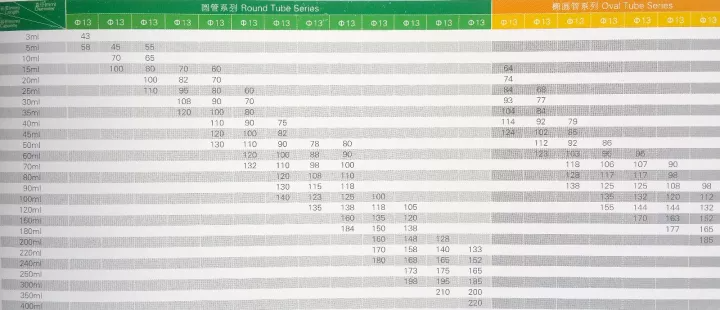
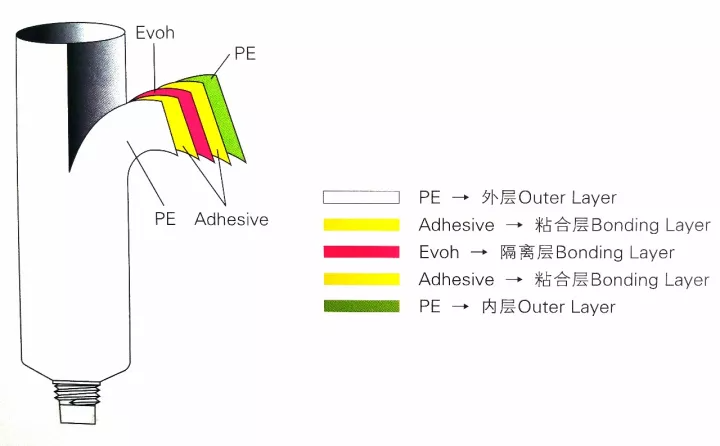
2. Tube tail
Some products need to be sealed after filling. The sealing tail can be roughly divided into: straight-line sealing tail, diagonal-line sealing tail, umbrella-shaped sealing tail, and special-shaped sealing tail. When sealing the tail, you can ask to print the required date code at the sealing tail.
3. Matching
A. Conventional matching
Hose caps have various shapes, generally divided into screw caps (single-layer and double-layer, double-layer outer caps are mostly electroplated caps to increase the grade of the product, which looks more beautiful, and professional lines mostly use screw caps), flat head caps, round head caps, nozzle caps, flip caps, super flat caps, double-layer caps, spherical caps, lipstick caps, and plastic caps can also be processed in a variety of processes, such as hot stamping edges, silver edges, colored caps, transparent, spraying, electroplating, etc., and pointed mouth caps and lipstick caps are usually equipped with inner plugs. Hose caps are injection molded products, and hoses are drawn tubes. Most hose manufacturers do not produce hose caps themselves.
B. Multi-functional matching
With the diversification of user needs, the effective integration of contents and functional structures, such as massage heads, balls, rollers, etc., has also become a new market demand.
Applications
The hose is light, easy to carry, durable, recyclable, easy to squeeze, and has good processing performance and printing adaptability. It is favored by many cosmetics manufacturers and is widely used in the packaging of cosmetics such as cleansing products (facial cleansers, etc.), skin care products (various eye creams, moisturizers, nourishing creams, vanishing creams and sunscreens, etc.) and beauty and hairdressing products (shampoo, conditioner, lipstick, etc.).
Post time: Jan-23-2025


